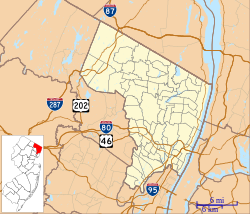
Fair Lawn is a borough in Bergen County, New Jersey, United States, and a bedroom suburb located 10 miles (16 km) from New York City. As of the 2010 United States Census, the borough's population was 32,457, reflecting an increase of 820 (+2.6%) from the 31,637 counted in the 2000 Census, which had in turn increased by 1,089 (+3.6%) from the 30,548 counted in the 1990 Census. Fair Lawn was incorporated as a borough by an act of the New Jersey Legislature on March 6, 1924, as "Fairlawn", from portions of Saddle River Township. The name was taken from Fairlawn, David Acker's estate home, that was built in 1865 and later became the Fair Lawn Municipal Building. In 1933, the official spelling of the borough's name was split into its present two-word form as "Fair Lawn" Borough.

The Steuben House is a noted example of Bergen Dutch sandstone architecture, located at New Bridge Landing on the Hackensack River in River Edge, in Bergen County, New Jersey, United States.

The table below includes sites listed on the National Register of Historic Places in Bergen County, New Jersey except those in Closter, Franklin Lakes, Ridgewood, Saddle River and Wyckoff, which are listed separately. Latitude and longitude coordinates of the sites listed on this page may be displayed in a map or exported in several formats by clicking on one of the links in the box below the map of New Jersey to the right.
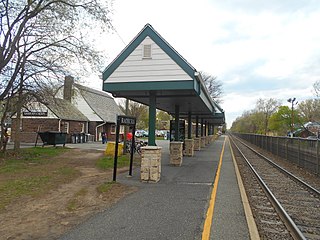
Radburn is a New Jersey Transit train station in the Dutch Colonial Revival style, served by the Bergen County Line. It is on Fair Lawn Avenue in the Radburn section of Fair Lawn, in Bergen County, New Jersey, United States. It is one of two New Jersey Transit train stations in Fair Lawn, the other being Broadway.

The Hermitage, located in Ho-Ho-Kus, Bergen County, New Jersey, United States, is a fourteen-room Gothic Revival house museum built in 1847–48 from designs by William H. Ranlett for Elijah Rosencrantz, Jr. Members of the Rosencrantz family owned The Hermitage estate from 1807 to 1970. The site was designated a National Historic Landmark for the excellence of its architecture and added to National Register of Historic Places in 1970. In 1971 it was added to the New Jersey Register of Historic Places.
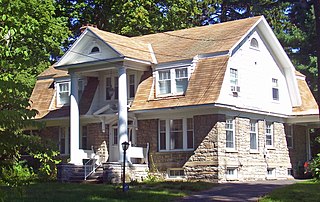
The George Felpel House is located on NY 9H in Claverack-Red Mills, New York, United States. It is a stone Colonial Revival and Dutch Colonial Revival house built in the 1920s.
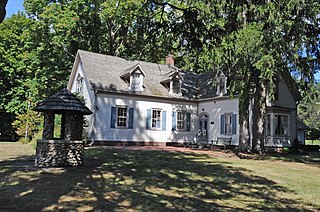
Ackerman—Dewsnap House is a historic house at 176 East Saddle River Road in Saddle River, Bergen County, New Jersey, United States. The house was built in 1837 and added to the National Register of Historic Places on August 29, 1986.

The Albert J. Zabriskie Farmhouse is located at the current address of 7 East Ridgewood Avenue in Paramus, Bergen County, New Jersey, United States, just east of New Jersey Route 17. This is one of several Zabriskie historic sites associated with the descendants of prominent settler Albrycht Zaborowski (1638–1711). This stone house was built in 1805 by Albert Jacob Zabriskie (1760–1835) in the New Jersey Dutch style, owned by four generations of the family until 1924, and added to the National Register of Historic Places on November 7, 1977. Due to confusion from the street name and handwritten notes on one page of the NRHP nomination, the building is sometimes mistakenly listed as being in Ridgewood, New Jersey.

Van Riper–Hopper House is located in Wayne, Passaic County, New Jersey, United States. The house was built in 1786 and was added to the National Register of Historic Places on August 21, 1972. The house is home to the Wayne Township Museum.

Jacobus Demarest House is located in New Milford, Bergen County, New Jersey, United States. The house was built in 1765 and was added to the National Register of Historic Places on February 17, 1978.

Tallman–Vanderbeck House, is located in Closter, Bergen County, New Jersey, United States. The house was built in 1778 and was added to the National Register of Historic Places on January 9, 1983.

The Michael Salyer Stone House is located on Blue Hill Road in Orangetown, New York, United States. It was built in the late 18th century.

The Jacob P. Perry House is a historic home on Sickletown Road in Pearl River, New York, United States. It was constructed around the end of the 18th century, one of the last houses in Rockland County to have been built in the Dutch Colonial style more common before the Revolution.

The Edward Salyer House is located on South Middletown Road in Pearl River, New York, United States. It is a wood frame house built in the 1760s.
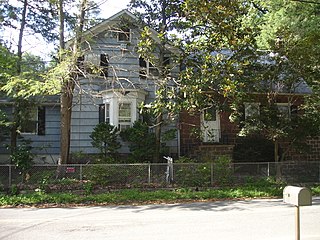
The Zabriskie Tenant House was a historic house of the American colonial architecture style called Dutch Colonial on Dunkerhook Road in Paramus, in Bergen County, New Jersey, United States, adjacent to the Saddle River County Park. The Zabriskie family, who farmed much of the area to the east of the Saddle River, built the home to house their domestic workers. It was one of the few structures left in New Jersey directly related to free African American communities in the state, and was a remnant of an African American Dunkerhook community that included several homes and an A.M.E. Church. The house was added to the National Register of Historic Places on July 24, 1984.

The Ackerman-Smith House is a historic house located in Saddle River, Bergen County, New Jersey, United States, built in 1760. It was added to the National Register of Historic Places on August 29, 1986.

Concklin-Sneden House is located in Rockleigh, Bergen County, New Jersey, United States. The house was built in 1796 and was added to the National Register of Historic Places on January 10, 1983.

The Naugle House is a historic house of the American colonial architecture style called Dutch Colonial on Dunkerhook Road in Fair Lawn, New Jersey, adjacent to the Saddle River County Park. It was constructed in the 1740s or 1750s on a small hillside along the Saddle River and is approached from Dunkerhook Road via a roadway that permits access to the park. The National Park Service Heritage Documentation Programs Historic American Buildings Survey took photographs and made architectural drawings of the house in 1938, and the National Park Service added the Naugle House to the National Register of Historic Places on January 9, 1983.

Readingsburg, also known as Stone Mill, is an unincorporated community located along the South Branch Raritan River within Clinton Township in Hunterdon County, New Jersey.

The Anthony–Corwin Farm is a historic farmhouse located at 244 West Mill Road near Long Valley in Washington Township, Morris County, New Jersey. It was added to the National Register of Historic Places on May 1, 1992, for its significance in architecture. The 11.5-acre (4.7 ha) farm overlooks the valley formed by the South Branch Raritan River. The farmhouse is part of the Stone Houses and Outbuildings in Washington Township Multiple Property Submission (MPS).


